Samurai in Japan: Class System-Related Morphological Differences in Maxillofacial Regions in the Edo Period
Abstract
1. Introduction
2. Materials and Methods
3. Results
4. Discussion
5. Conclusions
Author Contributions
Funding
Institutional Review Board Statement
Informed Consent Statement
Data Availability Statement
Acknowledgments
Conflicts of Interest
References
- Sakaue, K. Craniofacial variation among the common people of the Edo period. Bull. Natl. Mus. Nat. Sci. Ser. D 2012, 38, 39–49. [Google Scholar]
- Kanazawa, E.; Sakaue, K. Rate of congenital missing of the third molar in Japanese people in Edo period. Anthropol. Sci. 2018, 126, 5–13, (In Japanese with English summary). [Google Scholar] [CrossRef]
- Tanigawa, A. Tombs, burials and the Edo period. In Burial Facilities and Funerary Objects in Edo; Yoshikawa Kobunkan: Tokyo, Japan, 2004; pp. 224–250. (In Japanese) [Google Scholar]
- Oyamada, J.; Kitagawa, Y.; Manabe, Y.; Rokutanda, A. Dental pathology in the samurai and commoners of early modern Japan. Anthropol. Sci. 2004, 112, 235–246. [Google Scholar] [CrossRef][Green Version]
- Oyamada, J.; Igawa, K.; Kitagawa, Y.; Manabe, Y.; Kato, K.; Matsushita, T.; Rokutanda, A. Pathology of deciduous teeth in the samurai and commoner children of early modern Japan. Anthropol. Sci. 2008, 116, 9–15. [Google Scholar] [CrossRef][Green Version]
- Oyamada, J.; Kitagawa, Y.; Hara, M.; Sakamoto, J.; Matsushita, T.; Tsurumoto, T.; Manabe, Y. Sex differences of dental pathology in early modern samurai and commoners at Kokura in Japan. Odontology 2017, 105, 267–274. [Google Scholar] [CrossRef] [PubMed]
- Kaifu, Y. Changes in alveolar prognathism and anterior teeth protrusion in Japan. Anthropol. Sci. 1999, 107, 3–24. [Google Scholar] [CrossRef][Green Version]
- Miyajima, K.; McNamara, J.A., Jr.; Kimura, T.; Murata, S.; Iizuka, T. Craniofacial structure of Japanese and European-American adults with normal occlusions and well-balanced faces. Am. J. Orthod. Dentofac. Orthop. 1996, 110, 431–438. [Google Scholar] [CrossRef]
- Abbassy, M.A.; Abushal, A. Differences in dentofacial characteristics of Class I malocclusion between Saudi and Japanese adult females. J. Orthod. Sci. 2015, 4, 86–91. [Google Scholar] [CrossRef] [PubMed]
- Ioi, H.; Nakata, S.; Nakasima, A.; Counts, A.L. Comparison of cephalometric norms between Japanese and Caucasian adults in antero-posterior and vertical dimension. Eur. J. Orthod. 2007, 29, 493–499. [Google Scholar] [CrossRef] [PubMed]
- Shimizu, Y.; Arx, J.D.V.; Ustrell, J.M.; Ono, T. Comparison of cephalometric variables between adult Spanish and Japanese women with Class I malocclusion. J. Orthod. Sci. 2018, 7, 19. [Google Scholar] [CrossRef]
- Komlos, J. On English Pygmies and Giants: The Physical Stature of English Youth in the Late 18th and Early 19th Centuries; Emerald Group Publishing Limited: Bingley, UK, 2007; Volume 25, pp. 149–168. [Google Scholar]
- Öberg, S. Long-term changes of socioeconomic differences in height among young adult men in Southern Sweden, 1818–1968. Econ. Hum. Biol. 2014, 15, 140–152. [Google Scholar] [CrossRef]
- Rando, C.; Hillson, S.; Antoine, D. Changes in mandibular dimensions during the mediaeval to post-mediaeval transition in London: A possible response to decreased masticatory load. Arch. Oral. Biol. 2014, 59, 73–81. [Google Scholar] [CrossRef] [PubMed]
- Hayashi, K.; Saitoh, S.; Mizoguchi, I. Morphological analysis of the skeletal remains of Japanese females from the Ikenohata-Shichikencho site. Eur. J. Orthod. 2012, 34, 575–581. [Google Scholar] [CrossRef]
- Kaifu, Y. Tooth Wear and compensatory modification of the anterior dentoalveolar complex in humans. Am. J. Phys. Anthropol. 2000, 111, 369–392. [Google Scholar] [CrossRef]
- Sakaue, K. Secular changes in craniofacial morphology during the Edo period of Japan. Bull. Natl. Mus. Nat. Sci. Ser. D 2013, 39, 9–18. [Google Scholar]
- Baik, H.S.; Jeon, J.M.; Lee, H.J. Facial soft-tissue analysis of Korean adults with normal occlusion using a 3-dimensional laser scanner. Am. J. Orthod. Dentofac. Orthop. 2007, 131, 759–766. [Google Scholar] [CrossRef] [PubMed]
- Aoki, N. Food Diary of a Low-Class Bushi; Chikuma Shobo: Tokyo, Japan, 2005. (In Japanese) [Google Scholar]
- Harada, N. Food Life in the Edo Period; Iwanami Shoten: Tokyo, Japan, 2009. (In Japanese) [Google Scholar]
- Suzuki, H. Manifestation of the physical characteristics of Japanese aristocrats in the Edo era of Japan. J. Anthropol. Soc. Jpn. 1985, 93, 1–32, (In Japanese with English summary). [Google Scholar] [CrossRef]
- Vreeke, M.; Langenbach, G.E.; Korfage, J.A.; Zentner, A.; Grünheid, T. The masticatory system under varying functional load. Part 1: Structural adaptation of rabbit jaw muscles to reduced masticatory load. Eur. J. Orthod. 2011, 33, 359–364. [Google Scholar] [CrossRef] [PubMed][Green Version]
- Shimomoto, Y.; Chung, C.J.; Iwasaki-Hayashi, Y.; Muramoto, T.; Soma, K. Effects of occlusal stimuli on alveolar/jaw bone formation. J. Dent. Res. 2007, 86, 47–51. [Google Scholar] [CrossRef] [PubMed]
- Shimizu, Y.; Hosomichi, J.; Kaneko, S.; Shibutani, N.; Ono, T. Effect of sympathetic nervous activity on alveolar bone loss induced by occlusal hypofunction in rats. Arch. Oral. Biol. 2011, 56, 1404–1411. [Google Scholar] [CrossRef] [PubMed]
- Shimizu, Y.; Hosomichi, J.; Nakamura, S.; Ono, T. Micro-computed tomography analysis of changes in the periodontal ligament and alveolar bone proper induced by occlusal hypofunction of rat molars. Korean J. Orthod. 2014, 44, 263–267. [Google Scholar] [CrossRef] [PubMed]
- Hassan, M.G.; Kaler, H.; Zhang, B.; Cox, T.C.; Young, N.; Jheon, A.H. Effects of multi-generational soft diet consumption on mouse craniofacial morphology. Front. Physiol. 2020, 11, 783. [Google Scholar] [CrossRef] [PubMed]
- Inoue, M.; Ono, T.; Kameo, Y.; Sasaki, F.; Ono, T.; Adachi, T.; Nakashima, T. Forceful mastication activates osteocytes and builds a stout jawbone. Sci. Rep. 2019, 9, 4404. [Google Scholar] [CrossRef] [PubMed]
- Masumoto, T.; Hayashi, I.; Kawamura, A.; Tanaka, K.; Kasai, K. Relationships among facial type, buccolingual molar inclination, and cortical bone thickness of the mandible. Eur. J. Orthod. 2001, 23, 15–23. [Google Scholar] [CrossRef] [PubMed]
- Kasai, K.; Kanazawa, E.; Aboshi, H.; Tuisuva, J.; Takahashi, M.; Matsuno, M. Comparative study of craniofacial morphology and bite force in Fijians and Japanese. Am. J. Hum. Biol. 1998, 10, 63–72. [Google Scholar] [CrossRef]
- Kasai, K.; Kawamura, A. Correlation between buccolingual inclination and wear of mandibular teeth in ancient and modern Japanese. Arch. Oral. Biol. 2001, 46, 269–273. [Google Scholar] [CrossRef]
- Hayashi, R.; Kawamura, A.; Kasai, K. Relationship between masticatory function, dental arch width, and buccolingual inclination of the first molars. Orthod. Waves 2006, 65, 120–126. [Google Scholar] [CrossRef]
- Shimizu, Y.; Ishida, T.; Hosomichi, J.; Kaneko, S.; Hatano, K.; Ono, T. Soft diet causes greater alveolar osteopenia in the mandible than in the maxilla. Arch. Oral. Biol. 2013, 58, 907–911. [Google Scholar] [CrossRef] [PubMed]
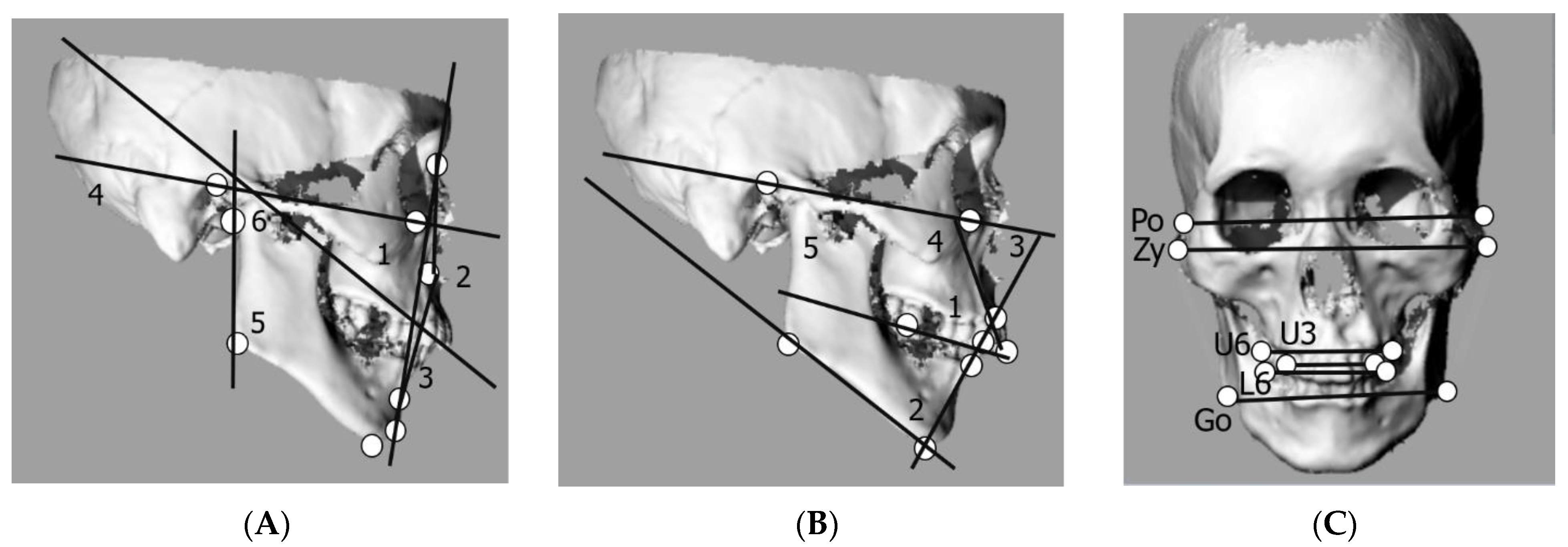
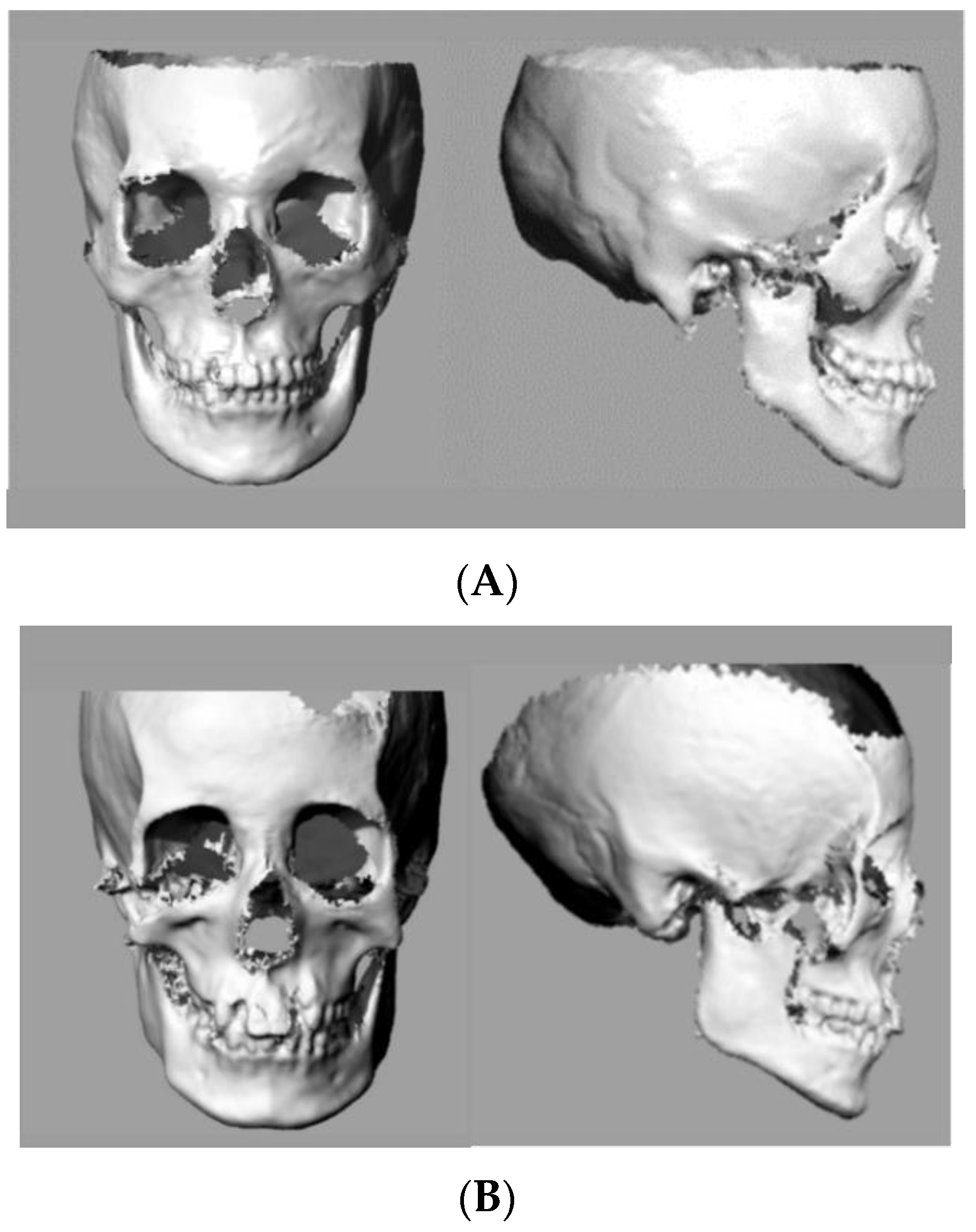
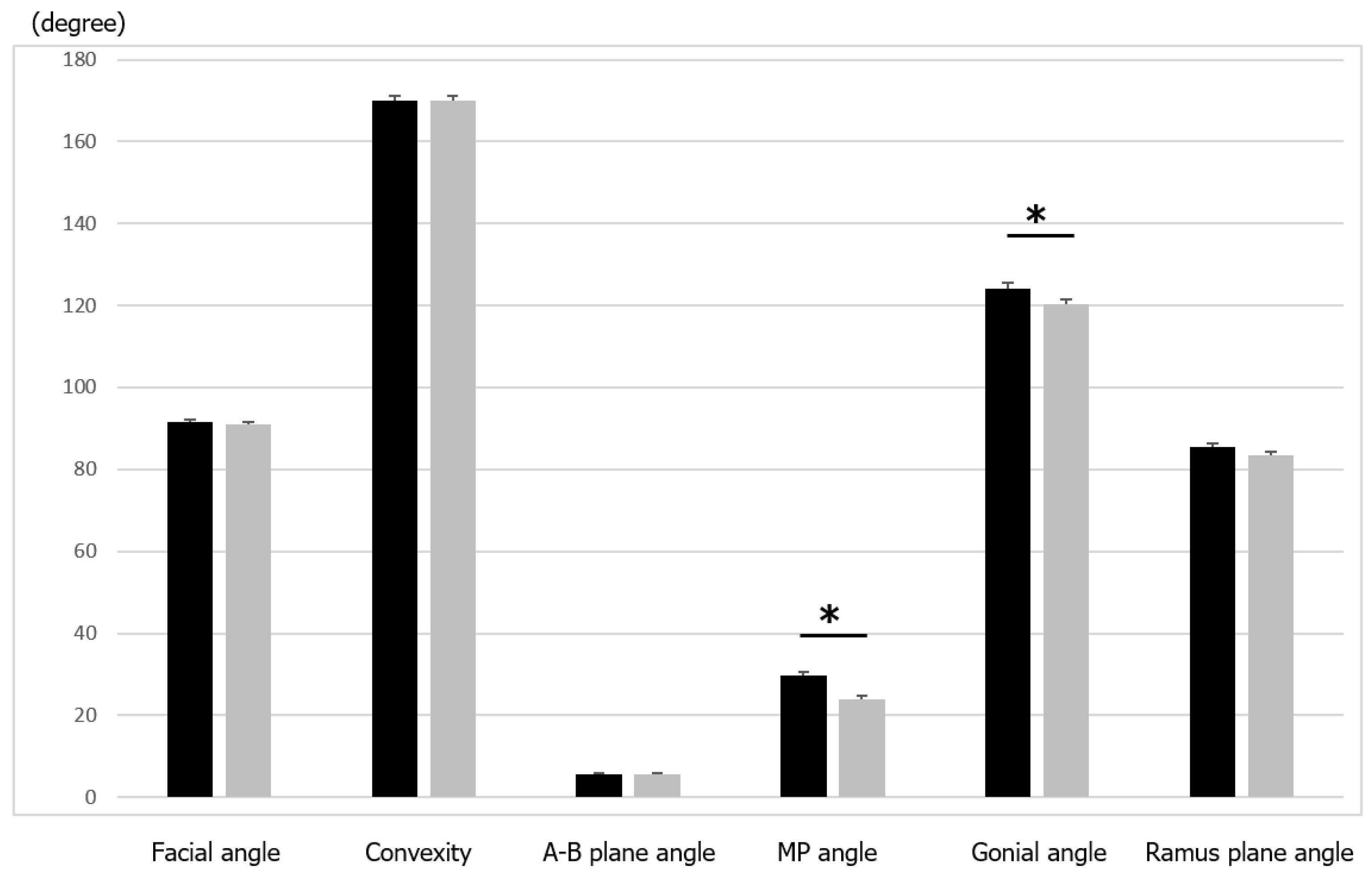
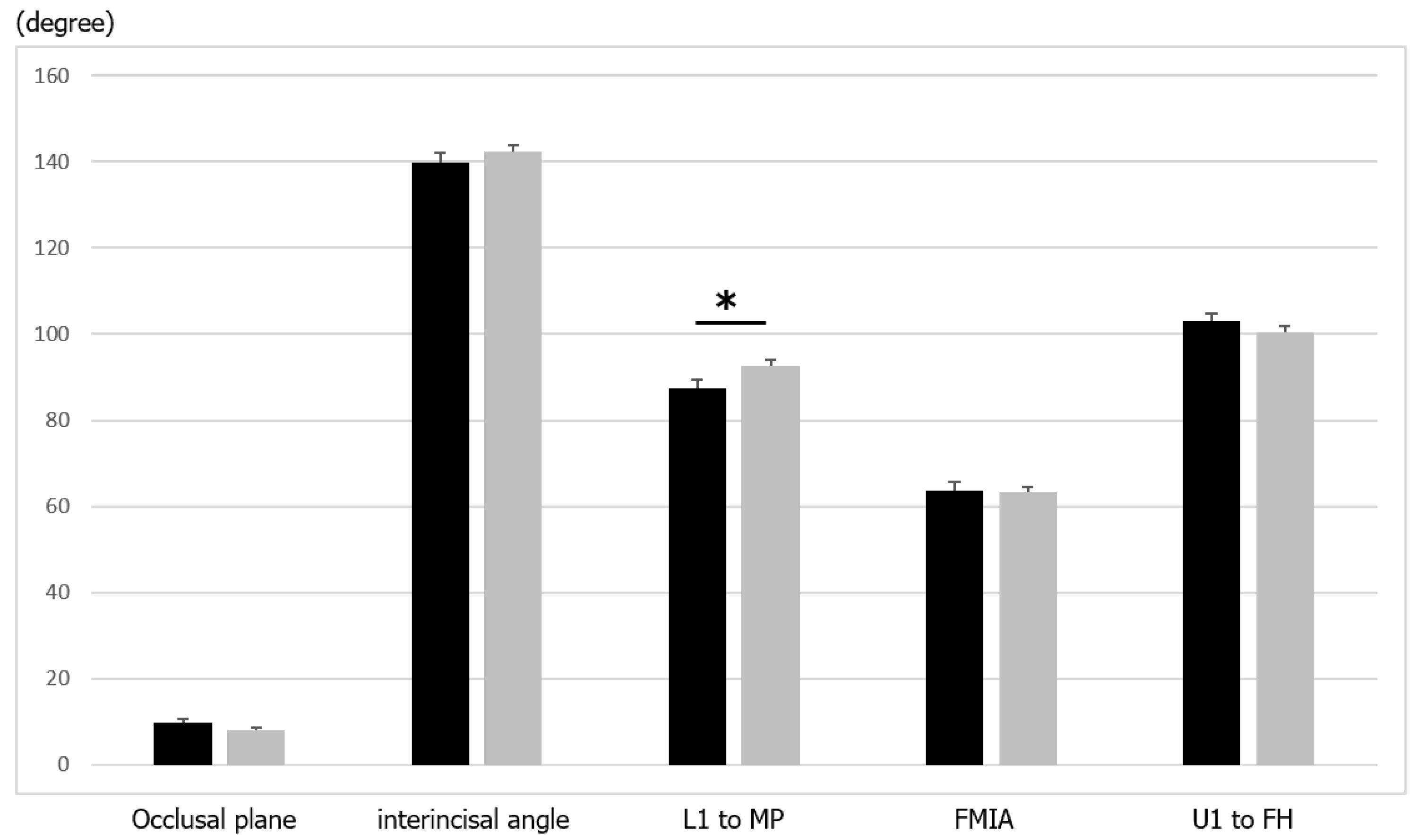
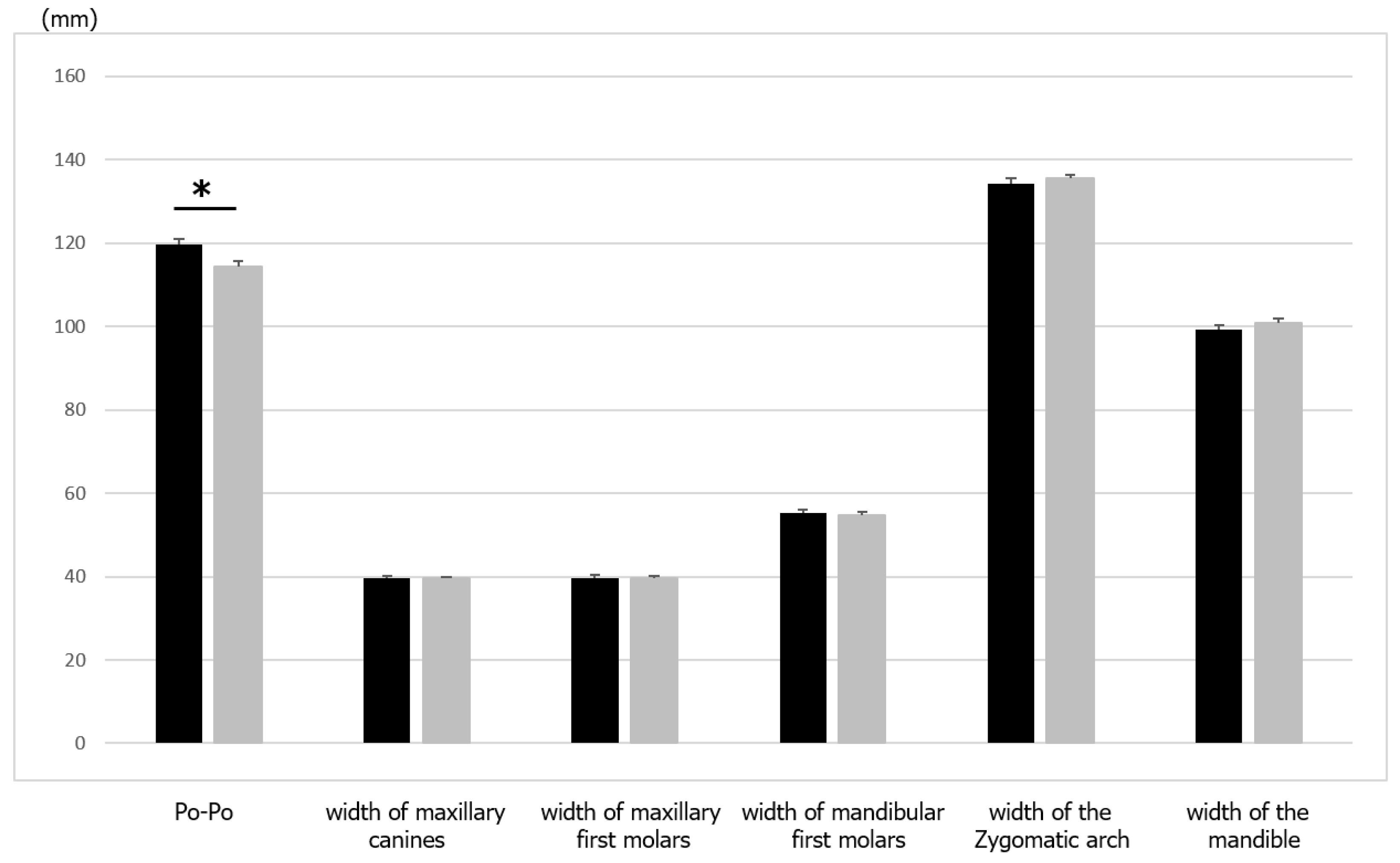
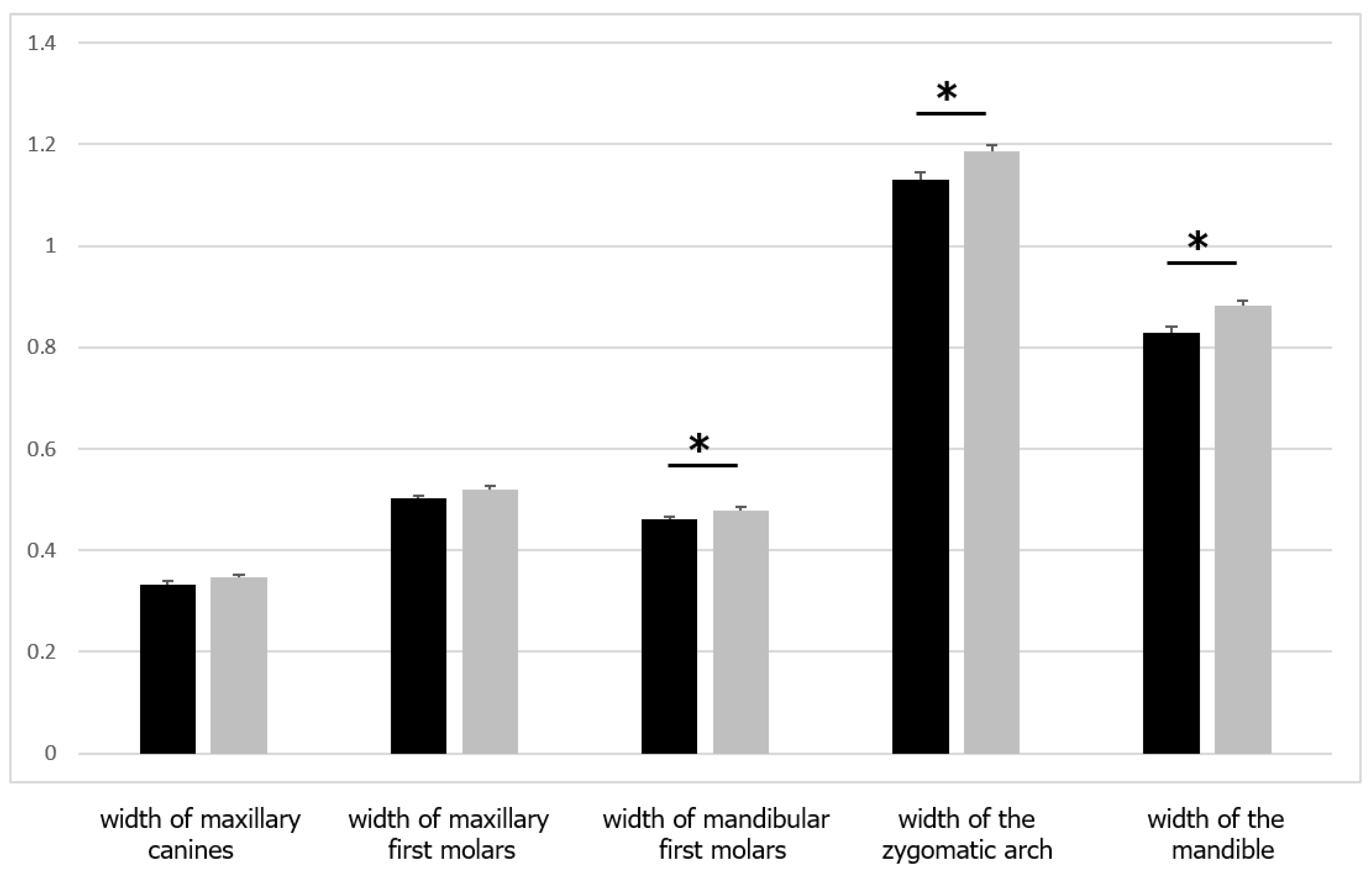
| Landmarks | Interpretation |
|---|---|
| Porion (Po) | The most lateral point on the roof of the bony external acoustic meatus, vertically over the middle of the meatus |
| Orbitale (Or) | The lowest point of the infraorbital margin |
| Nasion (Na) | The point on the skull corresponding to the middle of the nasofrontal suture |
| Point A (A) | The most posterior midline point on the premaxilla between the anterior nasal spine and prosthion |
| Point B (B) | The most posterior midline point, above the chin and on the mandible between infradentale and pogonion |
| Pogonion (Pog) | The most anterior point of the chin on the mandible in the midline |
| Menton (Me) | The most inferior point on the chin in the lateral view |
| Gonion (Go) | A point at the intersection of lines tangent to the posterior border of the ramus and the lower border of the mandible |
| Articulare (Ar) | A point at the intersection of the image of the posterior margin of the ramus and the outer margin of the cranial base |
| U1 | Axis of the maxillary central incisor constructed between the tip of the crown and apex |
| L1 | Axis of the mandibular central incisor constructed between the tip of the crown and apex |
| Variables (Degrees) | Samurai | Commoners | Probability |
|---|---|---|---|
| Facial angle | 91.49 ± 3.67 | 91.03 ± 3.44 | NS |
| Angle of convexity | 169.87 ± 6.79 | 170.09 ± 7.22 | NS |
| A-B plane angle | 5.55 ± 2.49 | 5.53 ± 2.83 | NS |
| Mandibular plane angle | 29.59 ± 5.27 | 23.74 ± 5.72 | * |
| Gonial angle | 124.15 ± 6.75 | 120.09 ± 6.86 | * |
| Ramus plane to FH | 85.35 ± 5.21 | 83.53 ± 5.03 | NS |
| Variables (Degrees) | Samurai | Commoners | Probability |
|---|---|---|---|
| Interincisal angle | 139.77 ± 11.41 | 142.39 ± 7.38 | NS |
| L1 to mandibular plane | 87.10 ± 11.20 | 92.56 ± 7.28 | * |
| FMIA | 63.78 ± 9.56 | 63.27 ± 6.54 | NS |
| U1 to FH | 102.87 ± 8.68 | 100.48 ± 7.12 | NS |
| Occlusal plane to FH | 9.80 ± 4.91 | 8.06 ± 4.35 | NS |
| Length (mm) | Samurai | Commoners | Probability |
|---|---|---|---|
| Po-Po | 119.57 ± 6.98 | 114.49 ± 6.45 | * |
| Intermaxillary canines | 39.62 ± 2.26 | 39.59 ± 2.02 | NS |
| Intermaxillary first molars | 59.54 ± 2.80 | 59.32 ± 3.17 | NS |
| Intermandibular first molars | 55.14 ± 3.41 | 54.85 ± 3.31 | NS |
| Interzygomatic arch | 134.33 ± 5.66 | 135.64 ± 4.40 | NS |
| Mandibular width | 99.21 ± 5.45 | 100.91 ± 6.18 | * |
| Ratio | Samurai | Commoners | Probability |
|---|---|---|---|
| Intermaxillary canines | 0.33 ± 0.03 | 0.35 ± 0.03 | NS |
| Intermaxillary first molars | 0.50 ± 0.03 | 0.52 ± 0.04 | NS |
| Intermandibular first molars | 0.46 ± 0.02 | 0.48 ± 0.04 | * |
| Interzygomatic arch | 1.13 ± 0.07 | 1.19 ± 0.07 | * |
| Mandibular width | 0.83 ± 0.05 | 0.88 ± 0.07 | * |
Publisher’s Note: MDPI stays neutral with regard to jurisdictional claims in published maps and institutional affiliations. |
© 2022 by the authors. Licensee MDPI, Basel, Switzerland. This article is an open access article distributed under the terms and conditions of the Creative Commons Attribution (CC BY) license (https://creativecommons.org/licenses/by/4.0/).
Share and Cite
Kawada, M.; Shimizu, Y.; Kanazawa, E.; Ono, T. Samurai in Japan: Class System-Related Morphological Differences in Maxillofacial Regions in the Edo Period. Int. J. Environ. Res. Public Health 2022, 19, 9182. https://doi.org/10.3390/ijerph19159182
Kawada M, Shimizu Y, Kanazawa E, Ono T. Samurai in Japan: Class System-Related Morphological Differences in Maxillofacial Regions in the Edo Period. International Journal of Environmental Research and Public Health. 2022; 19(15):9182. https://doi.org/10.3390/ijerph19159182
Chicago/Turabian StyleKawada, Masako, Yasuhiro Shimizu, Eisaku Kanazawa, and Takashi Ono. 2022. "Samurai in Japan: Class System-Related Morphological Differences in Maxillofacial Regions in the Edo Period" International Journal of Environmental Research and Public Health 19, no. 15: 9182. https://doi.org/10.3390/ijerph19159182
APA StyleKawada, M., Shimizu, Y., Kanazawa, E., & Ono, T. (2022). Samurai in Japan: Class System-Related Morphological Differences in Maxillofacial Regions in the Edo Period. International Journal of Environmental Research and Public Health, 19(15), 9182. https://doi.org/10.3390/ijerph19159182






